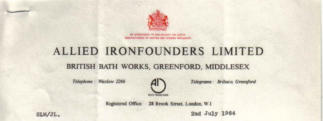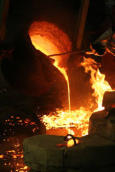
Travelling by London Transport Underground tube during the 60's on the Central
Line from Northolt to Greenford.
If you were awake enough in the morning and looking to the right, you may have
spotted two squat chimneys belching smoke.
These were above the smelting furnace of the British Bath Works in Long Drive,
Greenford. The foundry belonged to the Allied Ironfounders Group manufacturing
cast iron enamelled baths, the most popular design from Greenford in that era being
the 'Vogue'.
British Bath Works (BBW) operated 24 hours a day producing cast iron baths for
domestic and world markets.
Having worked there in for a short time, I can remember walking down Long Drive
where the houses were covered in soot and the ground vibrated to the constant
thump of the factory's castings shop.
When the molten iron had set and the rough castings released from the moulds, the
baths entered the chasing shop for de-burring. It was deafening and the air thick with
metal dust glistening in the light. Health and Safety standards were not as high as
today. The men, known as Fetlers, were using angle grinders to smooth off the
enamelling surface, most of whom neither had ear-defenders, nor respiratory masks.
The smoothed castings, now coated with flux, then entered the enamelling shop. I
remember the row of white-hot furnaces and the line of men dressed in 'asbestos'
suits and hoods. These were the highly skilled enameller operatives who were just a
few feet from the gaping furnace doors taking the red-hot baths out of the intense
heat using a large barrow-like 'forked leaver' and manually sprinkling the enamel
powder coating using a sieve. The operatives work was very hot, dangerous and
dusty, not to think of the health hazards to themselves and, indeed, to all who lived in
the area local to the works.
Around 1969 early one August morning, before the summer holiday shut-down there
was a huge explosion at the works. Without going into technicalities, this is an
employee’s account of the incident, “The foundry commenced melting iron and at a
pre determined time would ‘tap out’. That would simply mean tapping, more like
hammering, a bar through the bottom tap hole to let the iron out. This tap hole would
have been pre sealed during preparation of the cupola. They failed to tap out, but did
not close down the melting process. It gets a bit more involved, but basically they
carried on melting iron until abandoning trying to tap out. The floor under the cupola
had been washed down and they dropped the contents of about two tons of molten
iron onto it. Bang! Nobody was hurt but it blew all the asbestos covering off the
furnace and smashed all the windows in the lab where I worked. Luckily no one was
in there. On the explosion people panicked and one man tripped and another chap
ran over him leaving boot marks on his back. When I arrived the place was crawling
with fire engines and emergency services.”
As one of our BBW colleagues said, “It was a rough place, noisy, dirty and generally
unwholesome place to work but as one old foundryman put it ‘it's a place where men
are men, and boys become men’ - he could have fooled us!”
This was at the height of British Manufacturing. Quality control was stringent. A
slight blemish in the final product, a pit or bump in the enamel, and the bath was
smashed and recycled into the smelting furnace. If the consignment of baths was
destined abroad Crown Agents would normally carry out a secondary quality check
before shipping could take place. Most of my time was spent either in the office
under mounds of export documentation, or progress chasing consignments between
quality control and the packing shed. I remember goods coming into BBW from
other factories (e.g. Chrome Taps and Fittings) for inclusion in shipments destined to
far-off exotic sounding places.
Allied Ironfounders bought the ailing Bilston foundry and kept it running in
competition to Greenford and Cockburns at Falkirk. This resulted in Bilston becoming
the head company of Vogue Bathrooms in the 1970s after the subsequent take-over
by Glynwed. They shut down British Bath Works in 1975 and Cockburns in 1983,
and finally ceased production at Bilston in the early 1990s.




Vogue Bath







Click for www.gracesguide.co.uk/

















